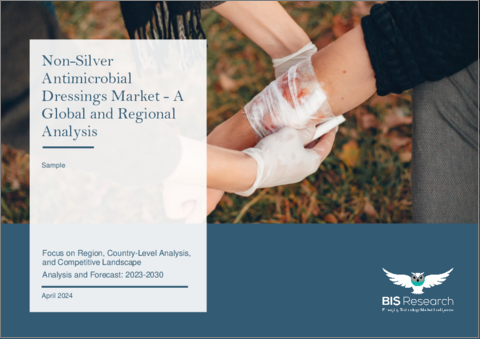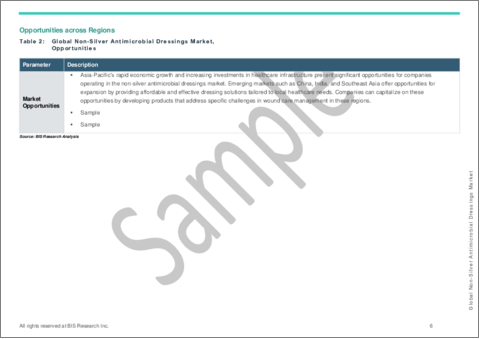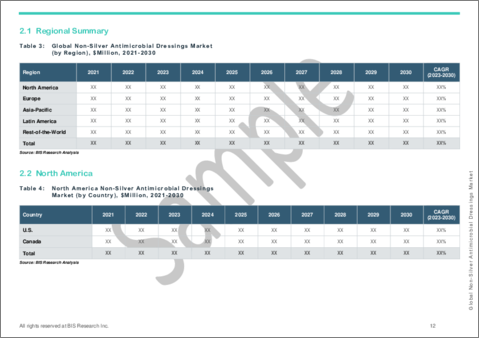|
|
市場調査レポート
商品コード
1489283
非銀系抗菌ドレッシング市場- 世界および地域別分析:地域、国別分析、競合情勢-分析と予測(2023年~2030年)Non-Silver Antimicrobial Dressings Market - A Global and Regional Analysis: Focus on Region, Country-Level Analysis, and Competitive Landscape - Analysis and Forecast, 2023-2030 |
||||||
カスタマイズ可能
|
|||||||
| 非銀系抗菌ドレッシング市場- 世界および地域別分析:地域、国別分析、競合情勢-分析と予測(2023年~2030年) |
|
出版日: 2024年06月06日
発行: BIS Research
ページ情報: 英文 41 Pages
納期: 1~5営業日
|
全表示
- 概要
- 図表
- 目次
世界の非銀系抗菌ドレッシングの市場規模は、2022年に4億2,090万米ドルとなり堅調な成長軌道にあります。
同市場は、2030年には5億6,580万米ドルに達すると予測されており、2023年から2030年にかけてCAGR3.75%で拡大するとみられています。非銀系抗菌ドレッシング材は、慢性創傷の管理と感染予防に効果的なソリューションを提供し、高度創傷ケアにおける極めて重要なツールとして浮上しています。
| 主要市場統計 | |
|---|---|
| 予測期間 | 2023年~2030年 |
| 2023年評価 | 4億3,720万米ドル |
| 2030年予測 | 5億6,580万米ドル |
| CAGR | 3.75% |
慢性疾患の罹患率が上昇し、感染対策への意識が高まる中、これらのドレッシングの需要は世界的に急増し続けています。
当レポートでは、世界の非銀系抗菌ドレッシング市場について調査し、市場の概要とともに、地域・国別の動向、および市場に参入する企業の競合情勢などを提供しています。
目次
エグゼクティブサマリー
第1章 市場
- 製品定義
- 包含基準と除外基準
- 主な質問への回答
- 分析と予測ノート
- 主な調査結果
第2章 地域
- 地域別概要
- 北米
- 米国
- カナダ
- 欧州
- ドイツ
- オーストリア
- チェコ共和国
- ギリシャ
- ポーランド
- ルーマニア
- ロシア連邦
- スロバキア
- トルコ
- ウクライナ
- ベルギー
- デンマーク
- フィンランド
- フランス
- アイルランド
- イタリア
- オランダ
- ノルウェー
- ポルトガル
- スペイン
- スウェーデン
- スイス
- 英国
- アジア太平洋
- オーストラリア
- 中国
- インド
- 日本
- マレーシア
- 韓国
- タイ
- ラテンアメリカ
- アルゼンチン
- ブラジル
- チリ
- コロンビア
- メキシコ
- 世界のその他の地域
第3章 市場-競合ベンチマーキング
- 主な戦略と開発
- 主要企業エコシステム
第4章 調査手法
List of Figures
- Figure 1: Global Non-Silver Antimicrobial Dressings Market, $Million, 2022, 2026, and 2030
- Figure 2: Global Non-Silver Antimicrobial Dressings Market (by Region), $Million, 2022, 2026, and 2033
- Figure 3: Key Market Trends in Global Non-Silver Antimicrobial Dressings Market, 2023
- Figure 4: U.S. Non-Silver Antimicrobial Dressings Market, $Million, 2021-2030
- Figure 5: Canada Non-Silver Antimicrobial Dressings Market, $Million, 2021-2030
- Figure 6: Germany Non-Silver Antimicrobial Dressings Market, $Million, 2021-2030
- Figure 7: Austria Non-Silver Antimicrobial Dressings Market, $Million, 2021-2030
- Figure 8: Czech Republic Non-Silver Antimicrobial Dressings Market, $Million, 2021-2030
- Figure 9: Greece Non-Silver Antimicrobial Dressings Market, $Million, 2021-2030
- Figure 10: Poland Non-Silver Antimicrobial Dressings Market, $Million, 2021-2030
- Figure 11: Romania Non-Silver Antimicrobial Dressings Market, $Million, 2021-2030
- Figure 12: Russian Federation Non-Silver Antimicrobial Dressings Market, $Million, 2021-2030
- Figure 13: Slovakia Non-Silver Antimicrobial Dressings Market, $Million, 2021-2030
- Figure 14: Turkey Non-Silver Antimicrobial Dressings Market, $Million, 2021-2030
- Figure 15: Ukraine Non-Silver Antimicrobial Dressings Market, $Million, 2021-2030
- Figure 16: Belgium Non-Silver Antimicrobial Dressings Market, $Million, 2021-2030
- Figure 17: Denmark Non-Silver Antimicrobial Dressings Market, $Million, 2021-2030
- Figure 18: Finland Non-Silver Antimicrobial Dressings Market, $Million, 2021-2030
- Figure 19: France Non-Silver Antimicrobial Dressings Market, $Million, 2021-2030
- Figure 20: Ireland Non-Silver Antimicrobial Dressings Market, $Million, 2021-2030
- Figure 21: Italy Non-Silver Antimicrobial Dressings Market, $Million, 2021-2030
- Figure 22: Netherlands Non-Silver Antimicrobial Dressings Market, $Million, 2021-2030
- Figure 23: Norway Non-Silver Antimicrobial Dressings Market, $Million, 2021-2030
- Figure 24: Portugal Non-Silver Antimicrobial Dressings Market, $Million, 2021-2030
- Figure 25: Spain Non-Silver Antimicrobial Dressings Market, $Million, 2021-2030
- Figure 26: Sweden Non-Silver Antimicrobial Dressings Market, $Million, 2021-2030
- Figure 27: Switzerland Non-Silver Antimicrobial Dressings Market, $Million, 2021-2030
- Figure 28: U.K. Non-Silver Antimicrobial Dressings Market, $Million, 2021-2030
- Figure 29: Australia Non-Silver Antimicrobial Dressings Market, $Million, 2021-2030
- Figure 30: China Non-Silver Antimicrobial Dressings Market, $Million, 2021-2030
- Figure 31: India Non-Silver Antimicrobial Dressings Market, $Million, 2021-2030
- Figure 32: Japan Non-Silver Antimicrobial Dressings Market, $Million, 2021-2030
- Figure 33: Malaysia Non-Silver Antimicrobial Dressings Market, $Million, 2021-2030
- Figure 34: South Korea Non-Silver Antimicrobial Dressings Market, $Million, 2021-2030
- Figure 35: Thailand Non-Silver Antimicrobial Dressings Market, $Million, 2021-2030
- Figure 36: Argentina Non-Silver Antimicrobial Dressings Market, $Million, 2021-2030
- Figure 37: Brazil Non-Silver Antimicrobial Dressings Market, $Million, 2021-2030
- Figure 38: Chile Non-Silver Antimicrobial Dressings Market, $Million, 2021-2030
- Figure 39: Colombia Non-Silver Antimicrobial Dressings Market, $Million, 2021-2030
- Figure 40: Mexico Non-Silver Antimicrobial Dressings Market, $Million, 2021-2030
- Figure 41: Data Triangulation
- Figure 42: Top-Down and Bottom-Up Approach
- Figure 43: Assumptions and Limitations
List of Tables
- Table 1: Market Snapshot
- Table 2: Global Non-Silver Antimicrobial Dressings Market, Opportunities
- Table 3: Global Non-Silver Antimicrobial Dressings Market (by Region), $Million, 2021-2030
- Table 4: North America Non-Silver Antimicrobial Dressings Market (by Country), $Million, 2021-2030
- Table 5: Europe Non-Silver Antimicrobial Dressings Market (by Country), $Million, 2021-2030
- Table 6: Asia-Pacific Non-Silver Antimicrobial Dressings Market (by Country), $Million, 2021-2030
- Table 7: Latin America Non-Silver Antimicrobial Dressings Market (by Country), $Million, 2021-2030
- Table 8: Rest-of-the-World Non-Silver Antimicrobial Dressings Market, $Million, 2021-2030
- Table 9: Key Initiatives, 2021-2024
- Table 10: Key Companies, Global Non-silver Antimicrobial Dressings Market
Introduction of Non-Silver Antimicrobial Dressings
The global non-silver antimicrobial dressings market, valued at $420.9 million in 2022, is on a robust growth trajectory and is anticipated to reach $565.8 million by 2030. This market is expected to expand at a compound annual growth rate (CAGR) of 3.75% between 2023 and 2030. Non-silver antimicrobial dressings have emerged as pivotal tools in advanced woundcare, offering effective solutions in managing chronic wounds and preventing infections.
Market Introduction
| KEY MARKET STATISTICS | |
|---|---|
| Forecast Period | 2023 - 2030 |
| 2023 Evaluation | $437.2 Million |
| 2030 Forecast | $565.8 Million |
| CAGR | 3.75% |
With the rising incidence of chronic diseases, coupled with growing awareness of infection control measures, the demand for these dressings continues to surge globally. This introduction provides a glimpse into the dynamic landscape of the non-silver antimicrobial dressings market, poised for significant expansion in the coming years.
Regional Segmentation:
- North America
- U.S.
- Canada
- Europe
- U.K.
- Germany
- France
- Italy
- Spain
- Netherlands
- Switzerland
- Russian Federation
- Turkey
- Poland
- Belgium
- Sweden
- Ireland
- Norway
- Austria
- Denmark
- Finland
- Portugal
- Czech Republic
- Romania
- Greece
- Slovakia
- Ukraine
- Asia-Pacific
- Japan
- China
- India
- South Korea
- Australia
- Malaysia
- Thailand
- Latin America
- Brazil
- Mexico
- Colombia
- Argentina
- Chile
- Rest-of-the-World
The regional analysis of the non-silver antimicrobial dressing market reveals a diversified landscape, with North America leading in market share, followed by Europe, Asia-Pacific, Latin America, and the Rest-of-the-World. North America, with a market value of $206.8 million in 2022, is anticipated to maintain its dominance throughout the forecast period, driven by factors such as advanced healthcare infrastructure, high adoption of advanced wound care products, and increasing prevalence of chronic wounds. Europe, with a market value of $104.6 million in 2022, is expected to witness steady growth propelled by rising healthcare expenditure and a growing aging population. Asia-Pacific is expected to emerge as the fastest-growing region with a CAGR of 4.57% from 2022 to 2030, fueled by expanding healthcare facilities, rising awareness of wound care management, and the presence of key market players investing in the region. Latin America and the Rest-of-the-World regions are also expected to show promising growth opportunities, driven by improving healthcare infrastructure and a rising focus on wound care management. This regional analysis underscores the global scope and potential of the non-silver antimicrobial dressing market, with each region contributing uniquely to its overall growth trajectory.
Recent Developments in the Non-Silver Antimicrobial Dressings Market
- In November 2023, Kane Biotech Inc., together with ProgenaCare Global LLP (""ProgenaCare""), announced the introduction of the newly rebranded Revyve Antimicrobial Wound Gel, previously known as Coactiv+ Antimicrobial Wound Gel.
- In May 2023, Kane Biotech Inc. received 510(k) clearance from the U.S. Food and Drug Administration (FDA) for its coactiv+ Antimicrobial Wound Gel. This clearance permits the use of the gel for managing various wounds in adults, including ulcers (such as diabetic foot and leg and pressure ulcers), first and second-degree burns, partial and full-thickness wounds, large surface area wounds, and surgical incisions.
- In February 2022, Argentum Medical, a leader in medical devices backed by Shore Capital and a pioneer in silver-plated nylon technology, announced its acquisition of Anacapa Technologies' product lines, including antimicrobial wound cleansers, gels, and irrigation solutions. Anacapa Technologies has been recognized as a market leader and innovator in developing antimicrobial wound care products.
- In June 2021, at RMIT University, Australia, researchers created advanced wound dressings equipped with embedded nanosensors that emit a glow to notify patients of improper healing. These multifunctional, antimicrobial dressings have been designed with fluorescent sensors that light up under UV light when an infection is present, allowing for monitoring of the healing process.
How can this Report add value to an Organization?
Product/Innovation Strategy: The market analysis provides insights into specific customer needs, enabling organizations to develop customized non-silver antimicrobial dressings that address unique regional requirements, such as climate conditions or prevalent wound types.
Growth/Marketing Strategy: The market analysis allows organizations to implement targeted marketing campaigns tailored to the preferences and behaviors of consumers in that specific region, leading to more effective customer engagement and higher conversion rates.
Competitive Strategy: Organizations can differentiate their non-silver antimicrobial dressings by highlighting features or benefits that are particularly valued by customers in the regional market, such as affordability, ease of use, or compatibility with local wound care protocols.
Methodology
Key Considerations and Assumptions in Market Engineering and Validation
- The base year considered for the calculation of the market size is 2022. A historical year analysis has been done for the period FY2019-FY2021. The market size has been estimated for FY2022 and projected for the period FY2023-FY2030.
- The scope of this report has been carefully derived based on interactions with experts in different companies worldwide. This report provides a market study of upstream and downstream products of non-silver antimicrobial dressings.
- The market contribution of non-silver antimicrobial dressings anticipated to be launched in the future has been calculated based on the historical analysis of the solutions.
- Revenues of the companies have been referenced from their annual reports for FY2022 and FY2023. For private companies, revenues have been estimated based on factors such as inputs obtained from primary research, funding history, market collaborations, and operational history.
- The market has been mapped based on the available non-silver antimicrobial dressings. This report has considered and profiled all the key companies with significant offerings in this field.
Primary Research:
The primary sources involve industry experts in non-silver antimicrobial dressings, including the market players offering products and services. Resources such as CEOs, vice presidents, marketing directors, and salespersons have been interviewed to obtain and verify both qualitative and quantitative aspects of this research study.
The key data points taken from the primary sources include:
- Validation and triangulation of all the numbers and graphs
- Validation of the report's segmentation and key qualitative findings
- Understanding the competitive landscape and business model
- Current and proposed production values of a product by market players
- Percentage split of individual markets for regional analysis
Secondary Research:
Open Sources
- Certified publications, articles from recognized authors, white papers, directories, and major databases, among others
- Annual reports, SEC filings, and investor presentations of the leading market players
- Company websites and detailed study of their product portfolio
- Gold standard magazines, journals, white papers, press releases, and news articles
- Paid databases
The key data points taken from the secondary sources include:
- Segmentations and percentage shares
- Data for market value
- Key industry trends of the top players of the market
- Qualitative insights into various aspects of the market, key trends, and emerging areas of innovation
- Quantitative data for mathematical and statistical calculations
Key Market Players and Competition Synopsis
The non-silver antimicrobial dressings market has been witnessing intensified competition as key players strive to capitalize on growing demand fueled by the rising incidence of chronic wounds and infections globally. Market leaders are leveraging advanced technologies and strategic collaborations to enhance product efficacy and expand their geographical reach. Innovations in biomaterials and antimicrobial agents are driving product differentiation, while stringent regulatory requirements pose a barrier to entry for new entrants. Moreover, the market has been characterized by a shift toward sustainable and biocompatible materials, driving companies to invest in research and development to gain a competitive edge.
Some prominent names established in this market are:
- Cardinal Health
- Essity
- Winner Medical Co., Ltd.
- Medline Industries
- DeRoyal Industries, Inc.
- Smith & Nephew
- Advanced Medical Solutions Limited
- L&R Group
- Organogenesis Inc.
- ConvaTec
- Kane Biotech Inc.
Table of Contents
Executive Summary
1 Markets
- 1.1 Product Definition
- 1.2 Inclusion and Exclusion Criteria
- 1.2.1 Inclusion
- 1.2.2 Exclusion Criteria
- 1.3 Key Questions Answered
- 1.4 Analysis and Forecast Note
- 1.5 Key Findings
2 Regions
- 2.1 Regional Summary
- 2.2 North America
- 2.2.1 U.S.
- 2.2.2 Canada
- 2.3 Europe
- 2.3.1 Germany
- 2.3.2 Austria
- 2.3.3 Czech Republic
- 2.3.4 Greece
- 2.3.5 Poland
- 2.3.6 Romania
- 2.3.7 Russian Federation
- 2.3.8 Slovakia
- 2.3.9 Turkey
- 2.3.10 Ukraine
- 2.3.11 Belgium
- 2.3.12 Denmark
- 2.3.13 Finland
- 2.3.14 France
- 2.3.15 Ireland
- 2.3.16 Italy
- 2.3.17 Netherlands
- 2.3.18 Norway
- 2.3.19 Portugal
- 2.3.20 Spain
- 2.3.21 Sweden
- 2.3.22 Switzerland
- 2.3.23 U.K.
- 2.4 Asia-Pacific
- 2.4.1 Australia
- 2.4.2 China
- 2.4.3 India
- 2.4.4 Japan
- 2.4.5 Malaysia
- 2.4.6 South Korea
- 2.4.7 Thailand
- 2.5 Latin America
- 2.5.1 Argentina
- 2.5.2 Brazil
- 2.5.3 Chile
- 2.5.4 Colombia
- 2.5.5 Mexico
- 2.6 Rest-of-the-World
3 Markets - Competitive Benchmarking
- 3.1 Key Strategies and Developments
- 3.2 Key Companies Ecosystem
4 Research Methodology
- 4.1 Data Sources
- 4.1.1 Primary Data Sources
- 4.1.2 Secondary Data Sources
- 4.1.3 Data Triangulation
- 4.2 Market Estimation and Forecast





